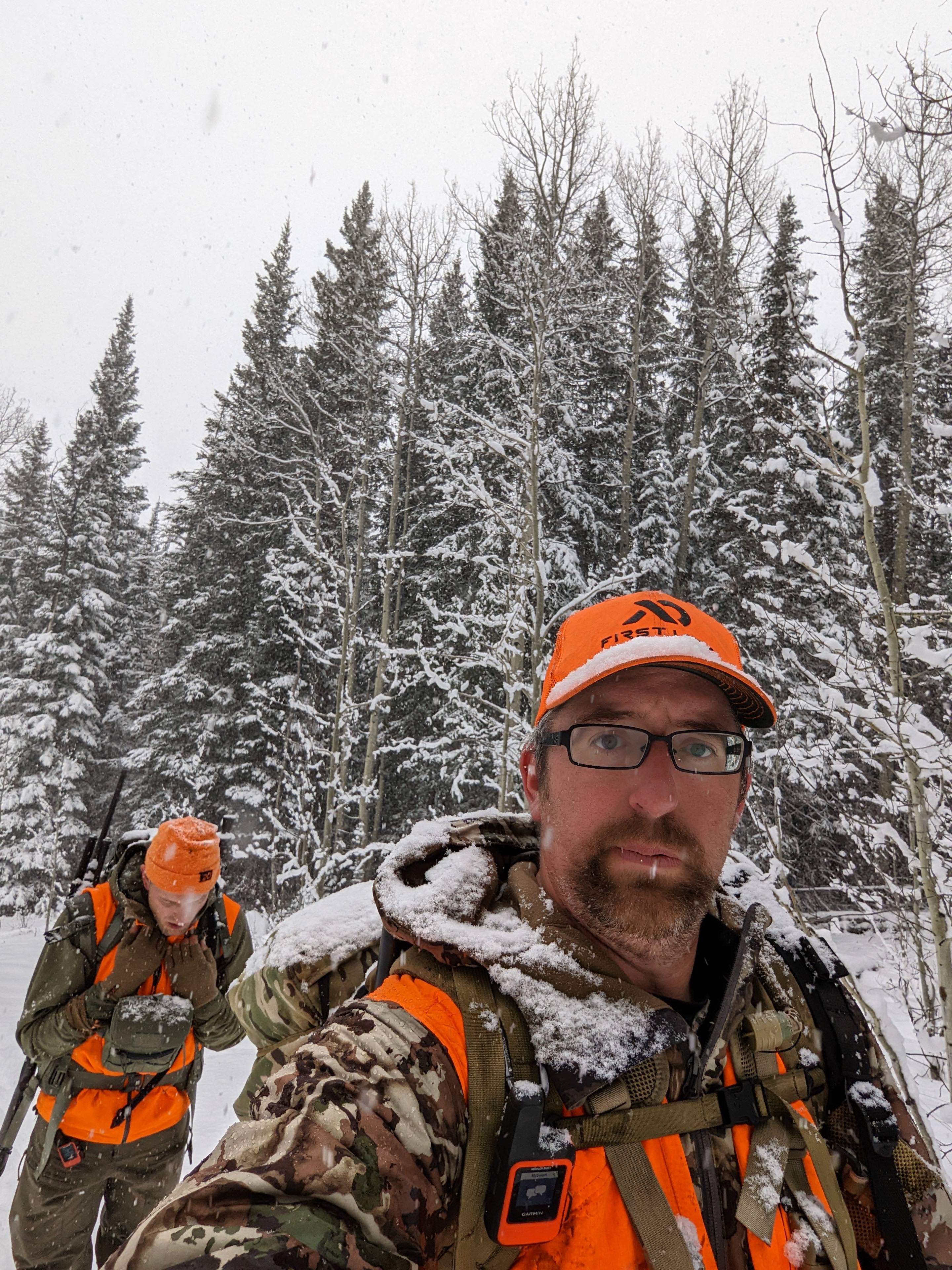At this point, still being relatively new to the backpack hunting game but having several seasons under my belt I’ve realized that packing meals for the adventure is no easy task. I agonize, and fret, balancing meals as best as I can — prepacking snacks and divvying up calories. I estimate milage and elevation changes. I’ve never left the wilderness feeling like I’ve starved myself. Here’s roughly how I take my meal planning for elk hunting into account when packing meals for my trip.
Calorie Calculations
It’s sometimes difficult to say how many calories you’ll need in a day. I’ve found that MTNTough Fitness has a spreadsheet that does calculations and gets it pretty close. There’s also a few formulas out there from various Army and Marine Corps field manuals that handle this sort of thing if you were to look.
Things to take into account are weight of the food, calories of the food, distance hiked, pack weight, elevation change, and humidity. These factors aren’t all inclusive but it’ll give you a decent mental picture with the complexities we’re dealing with here. For example, an Army Ranger trainee will be given two MREs at 1250 calories each for 2500 calories but over the course of a day may expend up to 10,000 calories working 18-20 hours a day rucking a heavy pack. That’s a huge caloric deficit. Even under my most austere conditions in camp I’m not putting in those sorts of days, or hiking under full load at all time — which ups calorie burn significantly.
For those of you not familiar with the military Meal Ready to Eat (MRE) it’s a full meal with a water based chemical heater. It provides hot chow in the field for our troops with nutrition required to keep them going, sometimes with dubious taste and texture. I used to carry MREs in the whitetail woods of Western Pennsylvania for many years but have since mostly eschewed them in favor of backpacking fare.
The calculations above are done using the Pandolf equation, which can potentially under-predict calorie burn under load according to recent academic studies. This will be exacerbated by mountainous conditions and say a larger load such as a pack out. Though if you’re successful — once you survive pack out the meals get really good. If you want to really geek out about your caloric intake and hiking under load, a great summary was put together from ACSM findings by Outside Magazine over at their website.
Picking Your Meals
There’s a few factors that play into picking your meals for your backcountry or car camping hunting trip. Honestly the chief amongst them when packing meals should be taste. Have you ever just boiled water and had a backpacking meal at home? Well why not? If you were to pack ten peanut butter and jelly sandwiches you’d better enjoy them. How else are you going to know that while the meal is amazing the preparation for Backpacker’s Pantry Pad Thai is absurdly involved. It’s not really the meal I want to be screwing around in low light conditions after doing the hurdle on blowdown for several hours making it back to camp. However, that’s going to be a meal when I have time in camp I’ll thoroughly enjoy.
Do yourself a huge favor and before your hunting season of choice go to a retailer and buy individual meals. During your preparation hikes take your kit with you and have a meal in the woods, or host a backpacking taste test with your hunting buddies. I have a soft spot for biscuits and gravy meals and the differences between all of them on the market are vast. It’s worth knowing which one you want in your pack or on your stomach when it’s sitting like a sack of quarters in your insides.
Other considerations, depending on the duration and the strenuous nature of whatever trip you’re on includes the caloric density of your food. That is, how heavy is the food for the calorie punch you get out of it?
Breaking it Down
Utilizing the MTNTough Spreadsheet above, I’ve picked out a few of my days worth of meals and snacks for analysis. This isn’t too far off from what I packed for my trip last year during elk season. However, the way in which I pack for this trip is heavy. Knowing that I will have access to the truck for several days, and I may spike in — but only for three or so days allows me to pack all the snacks I could need.
Let’s break it down. On a conservative day I can expect to make 6-8 miles worth of travel if I’m actively looking for elk. I’m a reasonably healthy 35 year old male with a little too much weight on me at 230 lbs or so. I can expect to do an elevation delta of roughly 1500-2000 feet on a daily based on climbing hills and dropping into valleys in the mountainous terrain I like to hunt. Plugging those numbers in is where things begin to get interesting.
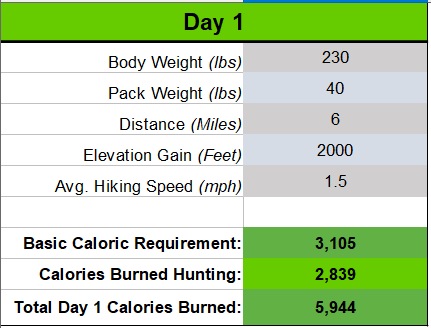
Counting Calorie Intake
Okay, from here we presume that I’m going to burn a bunch of calories by hiking with a net weight of 270lbs moving at 1.5 mph. Take a look at that total calorie burn for the day, pretty rough.
Now what did I pack to eat for this first day of travel? Generally speaking I eat two hot meals being breakfast and dinner. For the middle of the day I have a bunch of snacks that keep me moving, with a dose of carbohydrate drink mix or gummies for a boost.
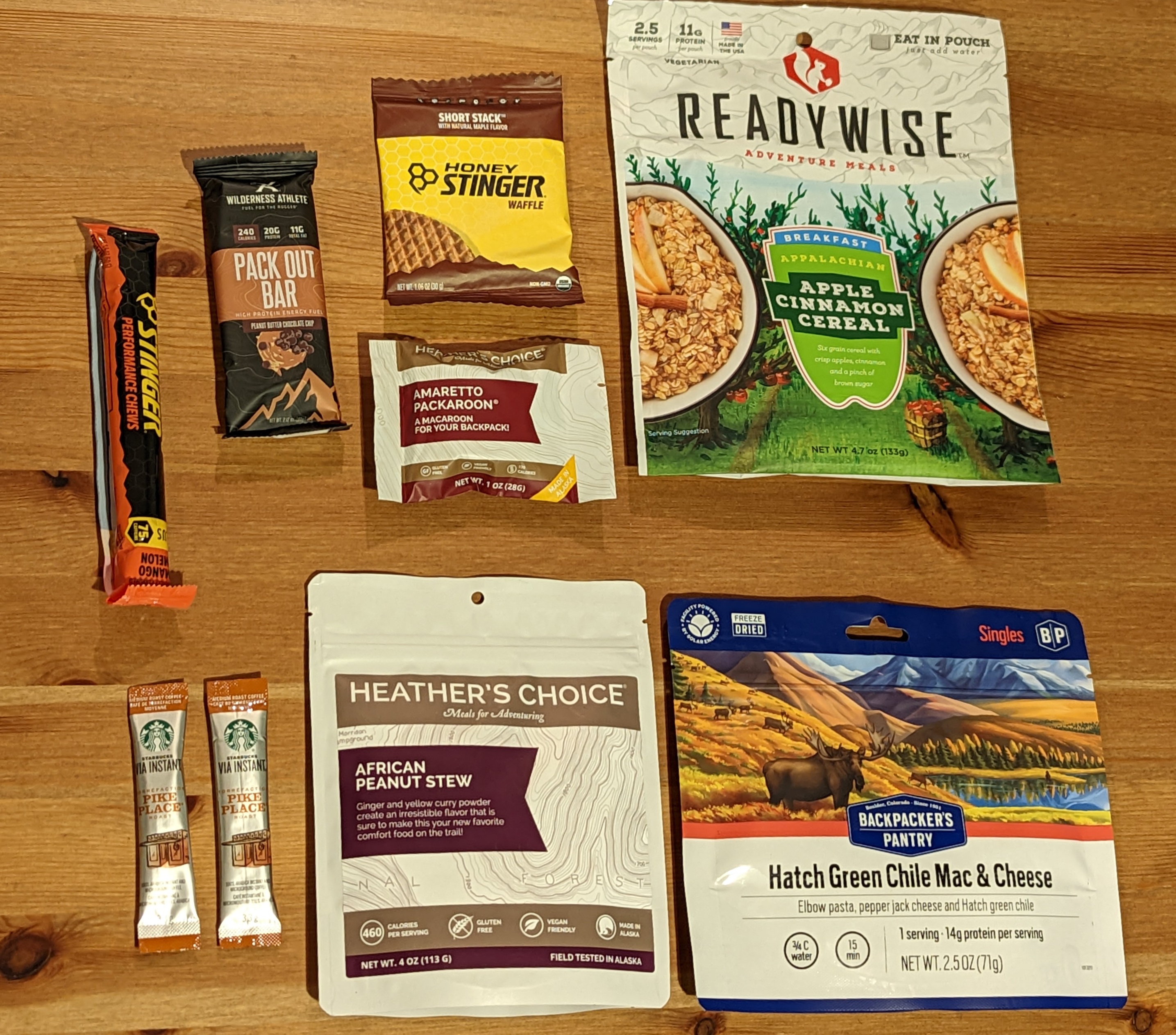
In the next tab on the MTNTough Backcountry Planner you can now enter your calorie counts for your snacks and meals. This is for a double entree dinner with Heather’s Choice African Peanut Stew and Backpacker’s Pantry Hatch Green Chili Mac and Cheese, 760 combined calories. Generally I’ll do something like this on a heavy travel day. Other entries are all single snacks or meals. The heavy hitter calorically speaking is the Wilderness Athlete Pack Out Bar at 240 calories. I’ll have that in the middle of the day while I’m sitting in order to absorb some calories at rest.
Let’s see how I did packing blind at home doing my normal meal work up for a trip.
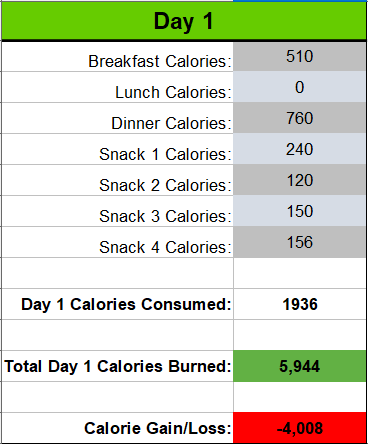
Consuming 1936 calories and burning 5944 puts me at a caloric deficit of 4008 calories. If I want to tighten that number up while minimizing weight gain in my pack I can add other calorically dense snacks or meals. The heavy hitters are going to be meats, cheeses, oils, nuts, or nut butters for a good calorie to weight ratio.
Buffing the Count
Adding some other calories to the mix that are very light weight when packing your meals are drink mixes. For a little variety throughout my trip I have a couple of drink mixes I enjoy and each pack a punch. They also help with electrolyte loss through sweating, which surely you’ll be doing plenty of.
| Mix | Calories | Weight |
|---|---|---|
| Alpine Spiced Apple Cider Mix | 80 | .74 oz |
| MTN Ops Ignite Pina Colada | 10 | .42 oz |
| MTN Ops Hot Ignite Mountain Mocha | 30 | .61 oz |
| Honey Stinger Rapid Hydration | 50 | .58 oz |
| Wilderness Athlete Hydrate and Recover | 40 | .49 oz |
Let’s circle back to those meats, nuts, and nut oils. The drink mixes are nice but don’t pack nearly enough calories to make much of a difference. Drinks, especially hot ones are a huge morale boost though.
The nuts, nut butters, and meats are going to be very calorically dense. While the above drink mixes help, they’re not going to stave off the jitters alone. The carbohydrate drinks and the hydrate and recover mixes help your body in other ways, but not in the form of calorie delivery.
| Snack | Calories | Weight |
|---|---|---|
| Epic Lamb, Currant, and Mint Bar | 130 | 1.3 oz |
| Epic Bison Cranberry Bar | 130 | 1.3 oz |
| Kirkland Dry Roasted and Salted Almonds | 270 | 1.6 oz |
| FBomb Nut Butter Macadamia Pecan with Sea Salt | 202 | 1 oz |
| Muir Energy Sunflower Butter | 148 | 1 oz |
| 2GO Coconut Oil with MCT Oil Single Serve Packet | 80 | .33oz |
Waste Reduction and Reuse
While I might get some flak for this I generally like to keep a day’s meal and snacks inside of a gallon ziploc bag. This allows for easy rationing and a better understanding of what is on the menu today. This makes packing meals and portioning easier at home or on the tailgate, and ensures you don’t oversnack. Environmentally, I recycle all of the bags on my trips until they’re functionally worthless.
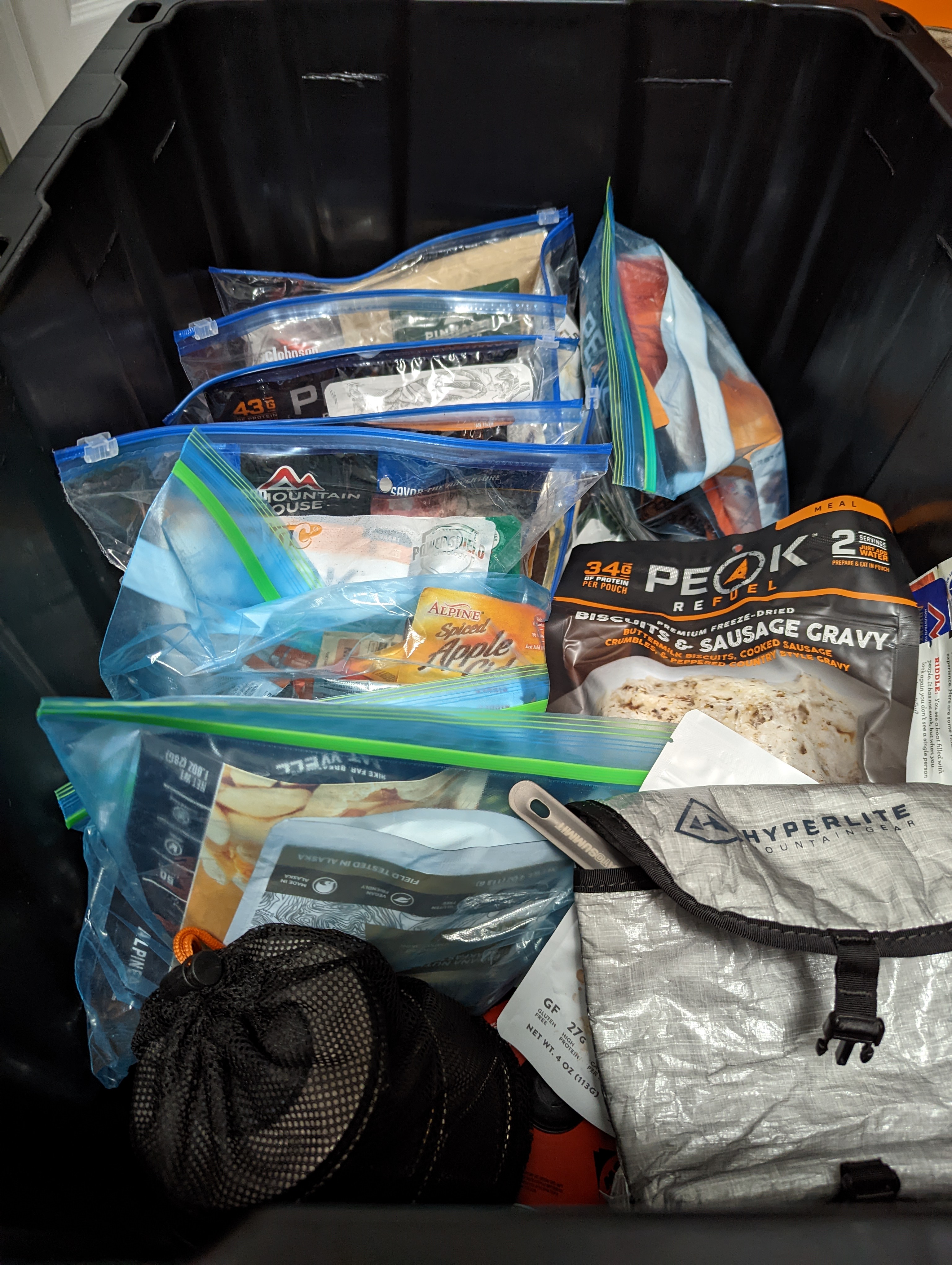
This also means that I have ten one gallon freezer bags on me during my elk and mule deer hunts in Colorado. This is both a blessing and a curse. If I down an animal and want to put organ meat somewhere, boom, I already have bags. If I want to put all of my garbage into a bag, boom, bag. However, it does seem a little wasteful, all of that mylar packaging from backpacking food. After the first day on the trail I have a garbage bag to collect all of the waste in order to keep my pack, and the great outdoors a little cleaner.
At the end of the trip I stuff all of the ziploc bags back into my bear cannister or tote for the next time I need to use them.
Packing and Tactics
Overall when packing meals I separate each day into a ziploc bag with all of my snacks and meals for the day. For fuel during backpacking I try to limit myself to two burns a day, but may up it to three for another cup of coffee in the morning. I pack very differently for a pure backpacking trip than I do when I have my truck nearby for base camp. Going in heavy like for truck camping allows me to carry only one bag’s contents, and perhaps another bag with me while hunting. This limits weight I’m carrying on my back but also limits distance.
Don’t Fret
After all of this agonizing and counting I say this. I’m no nutritionist, and I’m not exactly svelte by anyone’s definition. I have, however, had a lot of fun throughout the years truck camping and backcountry camping both solo and with friends. Take more snacks than you think you’ll need. Your pack gets lighter as the week grows on if you’re fit enough to carry it in the first place. Try to make sure the calories you put in your body are good, but not at the tradeoff of food you hate. Have fun, eat a bunch of different stuff, and enjoy the trail.
At the end of the hunt, you’ll probably want a big sweaty burger and a cold beer. Why shouldn’t you? You’ve earned it.


